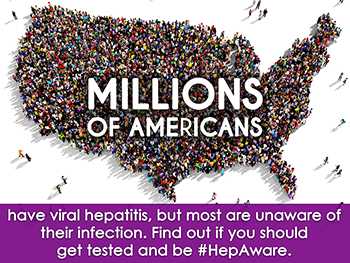Viral Hepatitis and Liver Cancer

For Hepatitis Awareness Month and national Hepatitis Testing Day on May 19th, learn how liver cancer is related to viral hepatitis. Find out if you should get tested or vaccinated for viral hepatitis by taking a quick, online Hepatitis Risk Assessment.
May is Hepatitis Awareness Month. In the United States, an estimated 3.5 million people are living with hepatitis C and up to 2.2 million people are living with hepatitis B. Hepatitis B and hepatitis C, the most common types of viral hepatitis in the US, can cause serious health problems, including liver failure and liver cancer. Unfortunately, new liver cancer cases and deaths are on the rise in the United States. Many of these liver cancer cases are related to infection with hepatitis B or hepatitis C.
Unfortunately, many people are unaware they are infected with hepatitis B and hepatitis C, and most people do not have symptoms or feel sick. To find out if you should be tested or vaccinated for viral hepatitis, CDC developed an online Hepatitis Risk Assessment. The assessment, which takes only five minutes, will provide personalized testing and vaccination recommendations for hepatitis A, hepatitis B, and hepatitis C. Below is a snapshot of the ABCs of viral hepatitis.
Hepatitis A
Hepatitis A is a short-term disease that is caused by infection with the hepatitis A virus. Hepatitis A was once very common in the United States, but the number of cases that occur each year is less than 3,000. Hepatitis A does not lead to liver cancer and most people who get infected recover over time with no lasting effects. Hepatitis A is easily prevented with a safe and effective vaccine, which is believed to have caused the dramatic decline in new cases in recent years. The vaccine is recommended for all children at one year of age and for adults who may be at risk, including travelers to certain international countries.

For Hepatitis Awareness Month, learn about the link between viral hepatitis and liver cancer.
Hepatitis B
Hepatitis B is a liver disease that results from infection with the hepatitis B virus. Hepatitis B is common in many parts of the world, including Asia, the Pacific Islands and Africa. Hepatitis B is also preventable with a vaccine. The hepatitis B virus can be passed from an infected woman to her baby at birth, if her baby does not receive the hepatitis B vaccine. As a result, the hepatitis B vaccine is recommended for all infants at birth. Unfortunately, many people got infected before the hepatitis B vaccine was widely available. That’s why CDC recommends anyone born in areas where hepatitis B is common, or whose parents were born in these regions, get tested for hepatitis B. Treatments are available that can delay or reduce the risk of developing liver cancer by 50%–80%.
Hepatitis C
Hepatitis C is a liver disease that results from infection with the hepatitis C virus. For reasons that are not entirely understood, people born from 1945 to 1965 are five times more likely to have hepatitis C than other age groups. In the past, hepatitis C was spread through blood transfusions and organ transplants. However, widespread screening of the blood supply began in 1990 and the hepatitis C virus was virtually eliminated from the blood supply by 1992. Today, most people become infected with hepatitis C by sharing needles, syringes, or any other equipment to inject drugs. In fact, rates of new infections have been on the rise in young people who inject drugs.
There is currently no vaccine to prevent hepatitis C. Fortunately, new treatments offer a cure for most people. Once diagnosed, most persons with hepatitis C can be cured in just 8 to 12 weeks, reducing liver cancer risk by 75%.
Find out if you should get tested or vaccinated for viral hepatitis by taking CDC’s quick online Hepatitis Risk Assessment.
More Information
For more information visit CDC’s Viral Hepatitis website.
Stay Connected
- Join the conversation on hepatitis by following @cdchep on Twitter.
- Sign up for email updates from CDC’s Division of Viral Hepatitis.
Resources
- Page last reviewed: May 10, 2017
- Page last updated: May 10, 2017
- Content source:
- National Center for HIV/AIDS, Viral Hepatitis, STD, and TB Prevention
- Page maintained by: Office of the Associate Director for Communication, Digital Media Branch, Division of Public Affairs




 ShareCompartir
ShareCompartir